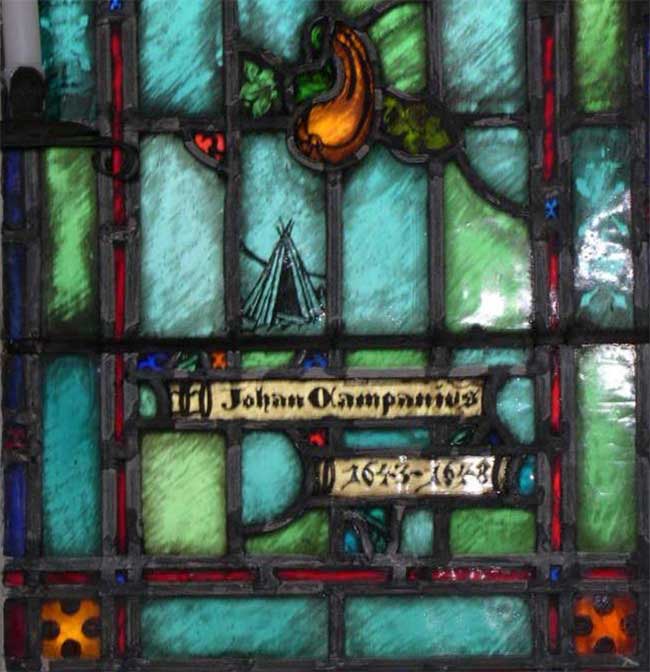JOHN CAMPANIUS RACKED UP FIRSTS IN AMERICA

[Campanius Window. "Fönstren I Christ Church (Old Swedes') Upper Merion, Pennsylvania." http://www.colonialswedes.se/Christ%20Church,%20Upper%20merion%20svensk%20HL.pdf]
SWEDEN ONCE HAD COLONIES on the east coast of North America.On this day, 16 August 1642, Queen Christiana of Sweden commissioned Lieutenant-Colonel John Printz as governor of New Sweden. She instructed him for his dealings with the native Americans and the English, and commanded him, “to labor and watch that he renders all things to Almighty God, the true worship which is his due.”
Printz sailed from Stockholm this same day. Aboard the Renown with him was a Lutheran pastor, John Campanius, who would assist Printz to fulfill the spiritual directives in Christiana’s commission. Campanius, who had been a teacher at an orphans’ seminary in Stockholm, was accompanied by his wife Margareta. The party stopped a while in Gottenburg, sailing into the Atlantic in November. They arrived at Fort Christina (Delaware) in mid-February 1643 (sometimes reported as 1642 because, under the old-style calendar, years ended in March). A severe storm off the coast of Delaware took off the ship’s main mast and several anchors and drove theRenownaground.
Campanius racked up a number of impressive firsts. Three years before John Eliot began his well-known missionary work among New England’s native Americans, Campanius reached out to the original inhabitants of Delaware. He learned their language, Lenni-Lenape, and translated Luther’s Small Catechism into it. Although this work was not published until 1696, long after Campanius had returned to Sweden, it is considered the first translation of a major European text into a North American native language.
In 1646, Campanius consecrated a log church, the first Lutheran church building in what later became the state of Pennsylvania, on Tinicum Island. That same year, Catharine Hanson was buried in its cemetery, the first person laid there.
During 1644 and 1645, Campanius recorded observations of the local weather twice a day, becoming the first man known to have kept such observations in North America. These records, as well as his historical notes, were later compiled by his grandson John Campanius Holm. This may have led to confusion of their names, for instance in the 1892 edition of Appleton’s Cyclopedia. The National Oceanic and Atmospheric Administration also issues its Campanius weather award for volunteer observers in Holm’s name. However, historian John Thomas Scharf suggests that “Holm” was added to designate Campanius’s origin in Stockholm.
In 1647, Campanius wrote his archbishop that he was weary of the work in New Sweden. He was allowed to return home the following year, leaving two hundred New World Lutherans in charge of his replacement Laurentius Laers, better known as Pastor Lock. Back in Sweden, Campanius served as chaplain to the admiralty, then as a rector in the Uppsala area, dying in 1683. He was buried in Frost Hults.
—Dan Graves
----- ----- -----
For more on the Christians who planted their faith in America, watch People of Faith at RedeemTV.
(People of Faith can be purchased at Vision Video.)
You can also read the companion magazine Christian History #102, People of Faith








